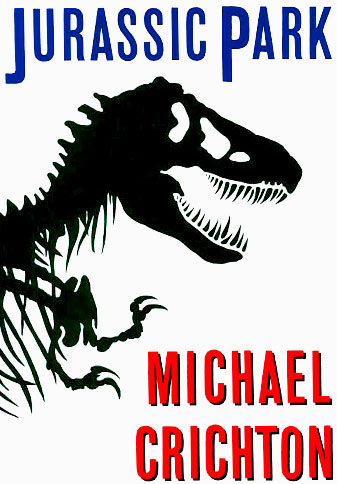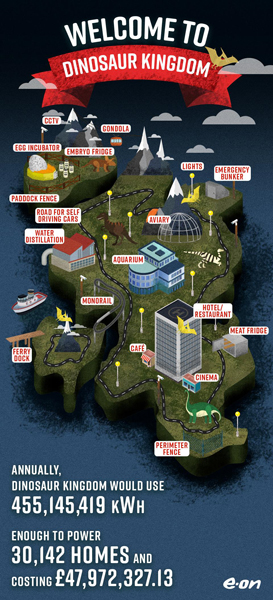Amazing Scientists Calculate the Cost of Powering a Dinosaur Theme Park
Scientists Calculate the Cost of Powering a Dinosaur Theme Park
This week, twenty-five years ago, saw the release of the film “Jurassic Park”, the Steven Spielberg directed blockbuster that brought to the world’s cinema screens CGI generated and animatronic dinosaurs. As cinema-goers currently enjoy the latest instalment in this multi-billion-dollar franchise – “Fallen Kingdom”, we could reflect on how our perceptions regarding the Dinosauria has changed since the adaptation of Michael Crichton’s 1990 novel first hit our screens.
Celebrating Twenty-Five Years of Jurassic Park

Powering “Fallen Kingdom”
We could comment on how these movies have enthused a whole generation of new scientists, with many opting for a career in palaeontology, first inspired by the amazing prehistoric animals brought to life on the silver screen. Instead, let’s leave the speculation to others about whether it would ever be possible to resurrect a long extinct group of animals, the last of which roamed the Earth sixty-six million years ago and consider one of the more practical aspects of converting an island into a dinosaur themed tourist attraction – how much power would it take to run Jurassic Park?
Thanks to E.ON and the assistance of some very clever physicists at Imperial College London, we have an answer to this question.
It would take 455 million kWh to power a real-life Dinosaur Kingdom. That’s enough to power half the homes in Harrogate for a year. Furthermore, team members at Everything Dinosaur have calculated, that based on an average UK household’s power consumption of around 5,000 kWh per annum, the annual power consumption of your typical prehistoric animal populated park would permit you to run the average UK home for around 91,000 years! That should be enough gas and electricity to see you comfortably through the next Ice Age.
The Cost of Powering a Prehistoric Animal Theme Park

Picture credit: E.ON
Running a Real-Life Jurassic Park
From a huge aquarium to house the semi-aquatic Spinosaurus to a dinosaur embryo cooling fridge and egg incubator, the physics experts investigated how much energy each feature would need to keep the park running over twelve months. The final figure calculated was 455,145,418 kWh, costing approximately £131,732 a day. We wonder how much money the owners of the theme park would have saved if they had instructed their geneticists to re-create dinosaurs as they probably were, that is, equipped with their own insulation in the form of downy, feathery coats.
If Feathered Dinosaurs had been Genetically Engineered – This Might Have Reduced the Annual Fuel Bill

Picture credit: Zhao Chuang PNSO
Modern Energy Solutions to Accommodate Ancient Animals
For any billionaire with aspirations to build a real-life “Jurassic Park”, having an understanding of the running costs would be an important component of the business plan.
Scott Somerville, E.ON’s Head of Advertising, PR and Campaigns, stated:
“With huge 10,000 volt electric fences and an aviary designed to house pterosaurs to name just two of the Dinosaur Kingdom’s unusual features, we suspected the energy needed to power the whole park would be big – possibly equivalent to powering a whole region within the UK. But what our figures show is that it’s actually a massive amount! It’s about the same as powering 30,142 average UK households a year – roughly equivalent to powering half the homes in Harrogate – but by adopting modern solutions, the power requirement and costs could be even less.”
Prehistoric Poo Turned into Power
The operators of any theoretical theme park, in which the main attractions would have quite happy consumed visitors for their breakfast, would need the very latest in safety features. There have been five films in the “Jurassic Park/Jurassic World” franchise to date and we all know what happens when things go wrong – it does not end well for the tourists. However, innovative and environmentally friendly methods of power generation could be adopted to keep those fences charged. The dinosaurs themselves could play a role in helping to keep running costs from mutating into monstrous proportions, as E.ON’s Scott Somerville went onto explain:
“By generating electricity using technology like a biomass fuelled Combined Heat and Power station, park owners could turn dinosaur droppings into electricity. Add on other solutions like solar and battery storage, then the park could ultimately benefit from a cheaper, sustainable and more reliable source of electricity instead having to deal with a ‘raptor rampage’ every time the generators that power the electric fences go down.”
For any would-be entrepreneurs with a few billion burning a hole in their pocket, further information on E.ON’s estimates of the running costs of a real-life dinosaur theme park can be found here: Dinosaur Kingdom Running Costs.
As for the rest of us, read the books, watch the movies, it is likely to be a lot less expensive and a good deal safer too.
If anyone or any organisation did really set out to create a dinosaur themed tourist attraction, populated by living, breathing, albeit genetically engineered prehistoric animals, then we suspect it would “spark” a Tyrannosaurus rex-sized debate. Feathers would be well and truly ruffled!
Visit the Everything Dinosaur website: Everything Dinosaur.

